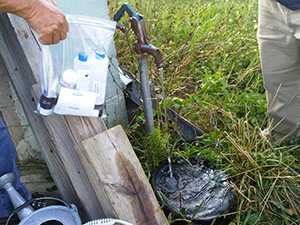Water-related Research

HSB staff photo
The Health Studies Branch investigates risks for exposure to and health effects from non-infectious contaminants in drinking water (e.g. metals, pesticides, nitrates, toxic chemicals) to identify hazardous exposures and develop recommendations for minimizing exposure and reducing public health risks.
There are many non-infectious agents that could contaminate water sources and impact human health. Common water contaminants and their associated health risks are listed on the Environmental Protection Agency (EPA) Drinking Water contaminants website. The majority of our investigations focus on drinking water sources that do not fall under regulation by the US EPA, such as private wells, small systems, and surface water. Working with local, state, tribal, federal, and international partners, we apply our research findings to develop recommendations and interventions to decrease population health risks. Examples of past investigations include:
- Evaluation of the Effectiveness of Private Well Owner Outreach Programs – 2014
- Description of Calls from Private Well Owners to a National Well Water Hotline – 2013
- Evaluation of Water Cistern Contamination and Health Risks in the Navajo Nation – 2011
- Investigation to Assess Risk Factors for Well Water Contamination after Flooding – 2010-2011
- Investigation of Drinking Water Exposures in Unregulated Water Sources in the Navajo Nation – 2008-2009
- Household Survey of Drinking Water Sources and Contaminant Exposures in the Navajo Nation – 2006-2007
- Occupational Exposure to Aerosolized Brevetoxins during Florida Red Tide Events: Effects on a Healthy Worker Population – 2005
- Page last reviewed: April 1, 2016
- Page last updated: April 1, 2016
- Content source:


 ShareCompartir
ShareCompartir